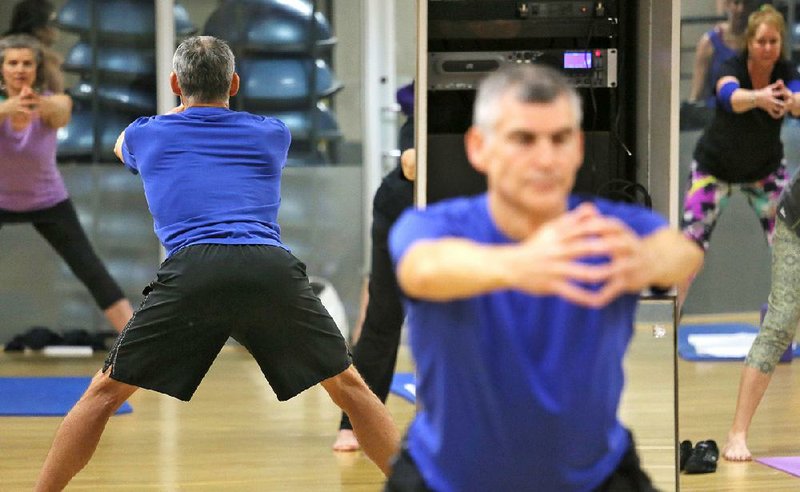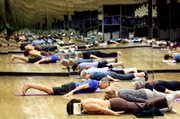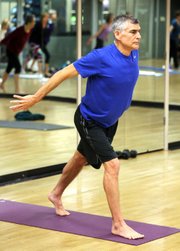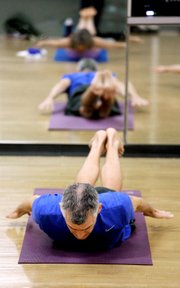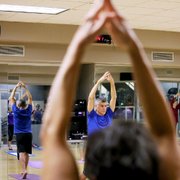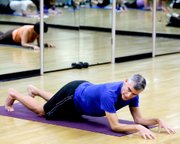Back pain lofts above the state on wings of black, red eyes searching, searching among the legions of the literate until they zero in on ...
What? Why? What did I ever do?
"You're not using the back of you at all," Claudia Smith observes, eyebrows raised.
I'm just sitting here, people, reading. Leave me alone. I don't want to think about this.
Exactly.
RELATED ARTICLE
http://www.arkansas…">Studio will offer workshop on Saturday in Fayetteville
With Tara Kelsey, Smith co-owns B-Fit Studio at 25 N. Block St. in Fayetteville, a personal training business that in the past focused on Pilates but now emphasizes a less familiar program called Foundation Training. And pain's chosen victim is ... whoever. An athlete or a desk jockey -- doesn't matter. When we sit, she says, our backsides are largely lax, and our minds are thinking about other things besides using those muscles in a coordinated fashion.
"And think about how much time we spend sitting," Smith says.
Eric Goodman, a Carpinteria, Calif., chiropractor who created Foundation Training, says anything we make our bodies do more frequently than other things is training. And so, sitting is a training regimen. Specifically, it trains the body to sit.
And the body adapts. In videos on the website foundationtraining.com, Goodman explains that -- besides encouraging us to stop engaging the powerful muscles on the posterior of the body when we actually need to -- sitting a lot compresses the spine. It also shrinks the chest, flattens the lumbar curve, tucks the pelvis and shortens hamstrings, sinks ribs into the waist and crowds internal organs. The chin juts; the neck strains to hold up the head; shadows fall; puppies cry.
Which is no biggie, except that sooner or later you have to get up to go play football with the NFL or do something totally insane like bending over to pick up the dog. And this is why the National Institute of Arthritis and Musculoskeletal and Skin Diseases lists having a sedentary job in the same paragraph with another big back-pain risk factor, having a job that requires heavy lifting, pushing or pulling. (There are other risk factors, too. See 1.usa.gov/21oE0h4.)
Unless we notice what's happening and take action to counter it, the body's "complacent adaptations" to sitting degrade the way we move, Goodman says.
Accidents, poorly planned workouts (yes, even core workouts) and becoming very, very good at one sport also can accomplish the same bad thing: Movements that should be led by back-of-the-body powerhouses including the arse and legs are instead done by the muscles we keep wishing looked like a six pack.
But really, Goodman says, pain isn't the problem. It's a symptom.
The problem is unsafe movement habits.
Springdale physical therapist Joe Paul sees Goodman's Foundation Training as a "very good" program healthy people could do to prevent back trouble.
Paul has been a physical therapist 28 years. He practices Foundation to manage his own, serious spine problems, and he sees the techniques help patients at Total Spine, a Division of Northwest Arkansas Neurosurgery Clinic.
"In some cases, Foundation Training has been the critical ingredient in giving a patient control of their spine, decreasing their pain and allowing them to return to activities they had lost hope in ever doing again," Paul says. "It is a great adjunct to the arsenal of methods we use to get these folks moving again. In some cases, Foundation Training is the only thing we are using."
In other cases, it's not appropriate, he notes.
He names a few, starting with any new or severe pain: "acute nerve compression syndromes such as newly herniated or ruptured discs; acute spinal fractures; unstable spondylolisthesis; severe spinal stenosis; acute neck or low back pain ...
"This is by no means a complete list, and one should always check with their physician before trying any new exercise regimen."
That sentiment is a fitness program boilerplate for good reason. The wrong regimen can wreck a back.
Paul began his acquaintance with Foundation after a crisis in his spinal situation, when his wife suggested he download a two-disc DVD set -- Foundation Training: From Pain to Performance -- from Goodman's website. (Digital download or physical discs cost $59.99.)
"Nothing can replace" working hands-on with a qualified instructor, he says, but "the models are great at demonstrating good technique versus bad." Beginners should "pay close attention."
Goodman advises beginners to spend about a month with Disc One before attempting Disc Two. "Don't jump ahead," Paul agrees.
"Anyone trying Foundation Training on their own should be aware that some
soreness is normal with any new exercise program," he says, but if doing Foundation causes big pain, stop. Check with your doctor.
(He, his wife and one of the clinic's physical therapy assistants, Shannon Wilks, have become Foundation instructor candidates. They have yet to pass all the requirements to be fully certified teachers, including a four-day workshop.)
ACCESSORIZE
"What was very appealing about Foundation Training is it's simple, accessible movement that can be put into your everyday life ... not a flash-in-the-pan big trend, but a reorganization of some really good principles of human movement," Smith says, explaining why she and Kelsey certified to teach the method.
They still do Pilates and yoga, "and I love all that stuff," Smith says. "It's not meant to replace that stuff" -- walking, running, Pilates, skating, football, CrossFit, Zumba ... whatever. Foundation is designed to accessorize a larger program or sports training.
"I'm CrossFit certified, too, to teach," says another Foundation-certified instructor, Lisa Cooper, "and you'd think they're extreme opposites. But they're the best complements."
Cooper teaches Foundation at Little Rock Racquet Club and at Little Rock Athletic Club in west Little Rock, where she is director of fitness and group exercise. Cooper's former boss, Pat Riley Jr., is also a certified instructor and teaches at the Athletic Club. (Riley sold that facility, the Racquet Club and North Little Rock Athletic Club when he retired in 2013.)
FAMILIAR BUT FOREIGN
Downstairs in Little Rock Athletic Club's fitness room, glance at Riley's Foundation class and it looks like yoga. Students are mostly women, barefoot on sticky mats, and they're holding poses.
The poses look easy. And they are -- at first.
"It's surprising how hard this class can be for only a 25-minute class," says student Mary Remmel Wohlleb, who began attending a year ago, hoping to strengthen her lower back. ("And it seems to have helped.")
The exercises include "the founder" -- isometric forward bends (done while standing, squatting or kneeling) in which the focus is on using the hips to hinge forward instead of bending the spine. Legs and gluteals must be contracted strongly, the torso braced so ribs stay lifted off the waist; and the fanny is pressed back, weight on the heels ("putting your weight in your back pockets," as Smith says).
There are anchored hip bridges done lying supine while trying to drag the heels toward the body. There are long stretches called decompressions; there are crossover stretches. There's a standing lunge in which students reach as high as possible, actively lifting their weight off the ground.
The arms come down and then reach forward and to one side, and the lunge becomes a rotated form of the founder called "the woodpecker."
Students say their lower backs warm and their legs shake, but they aren't panting. Teachers say the effects will be felt less from what goes on during class and more from how students apply the principles the rest of the day.
Gail Wells, 77, takes Cooper's class at the Racquet Club. "One thing it does is it reminds you to push your bum back," she says.
Every fall oaks pepper her lawn with acorns, and if she doesn't collect them, a mini forest takes root. Before Foundation, she wasn't able to clear the whole yard at once, because that hurt. But this time "I did the whole patch," she says.
ELITE AND LESS SO
Goodman began developing Foundation while struggling with his own degenerated discs in his mid-20s -- while he was in chiropractic school (his TedX video is at bit.ly/24kB87p). After he chose to think of his pain as a symptom, he began to understand why he was moving incorrectly.
He refined his ideas with strength and conditioning specialist Peter Park of Santa Barbara, Calif., who trains elite athletes. Lance Armstrong wrote the foreword to their book, Foundation: Redefine Your Core, Conquer Back Pain, and Move With Confidence (Rodale Books, 2011). And today Goodman's website carries testimonials from surfers Kelly Slater, Dane Reynolds and Lakey Peterson; actors Matthew McConaughey, Rob Lowe and Jeff Bridges; basketball player Derek Fisher; pro cyclist Lucas Euser; Terry Schroeder, head coach of the USA Olympic water polo team ...
Goodman's story -- personal trainer at age 18, candidate for spine surgery at 25 -- resonates with Riley, another lifelong athlete who has suffered crippling bouts of back pain since age 17, when his first spasms struck after a swim practice involving the butterfly stroke. His diagnosis is spondylolisthesis, insufficient space between his fourth and fifth lumbar vertebrae, and also scoliosis: "My spine is not straight," he says.
"I would say 10 years ago I was probably spending eight or nine days a year where I couldn't stand up because my back would be in spasm," Riley says.
He walked, saw a chiropractor, did yoga, "and I would say everything has helped." Then his sister, Katherine Shoulders (former co-owner of Fayetteville Athletic Club who lives in Boulder, Colo.), told him about Foundation, and "I got the book and I got the DVD, and I started doing the exercises on my own.
"I would just do three every day," he says. "Within two weeks, my back pain issues lessened. I haven't had a back episode since I started doing it, which was three years ago."
He knows that men looking in on his class assume it's not manly. "Most guys also will tell you they have some back issues, too. ...
"This is subtle, although if you do it, you really do it -- oh man. That's why the class is so short. It doesn't take much time to make a big difference."
ActiveStyle on 02/29/2016
